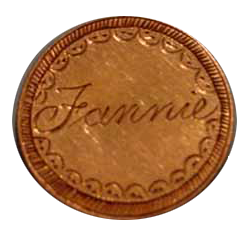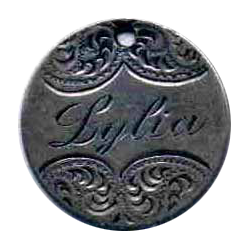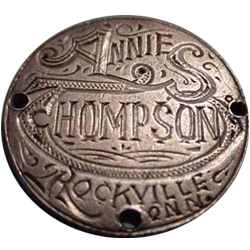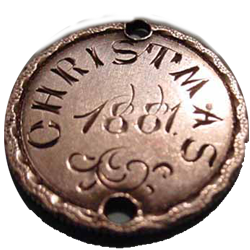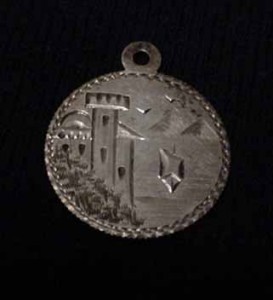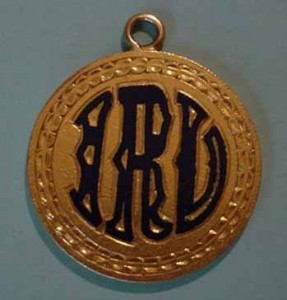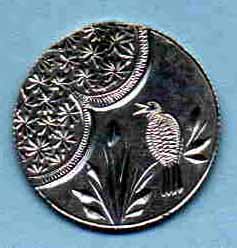What Are Love Tokens?
The Love Token is a coin that has been smoothed flat on one or both sides and then hand engraved. Engravings are most commonly initials of the giver. Names and dates were also popular and perhaps most special and scarcer were sayings and pictures. Some love tokens were embellished even further with stones, enamel, added raised metal, or cutout designs within the coin. These coins were made as keepsakes and mementos from the giver to the recipient. The giver, important date, place, or event was intended to be remembered through the love token; a commissioned testimony and executed one of a kind special engraving.
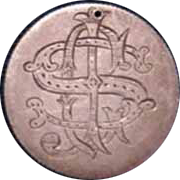
"JSG" intertwined on a <1874> dime. Note that it has a hole at the top and no border around the edge. Three initials are the most common love token engraving.
There are two basic requirements for a love token:
- First: The engraving must be on a legitimate coin (i.e. coin of the realm).
- Second: The engraving must be done by hand.
Of course if a coin is engraved on both sides, it becomes more challenging to identify. Most U.S. coins have a reeded edge, so love token collectors accept the presence of a reeded edge to be a legitimate coin. The three cent nickel and the nickel pose a problem with no identifying marks on the rim. Also, a coin that has been cut down into another shape (diamond, clover, etc…) loses its edge diagnostics. In these cases, it is up to the collector whether they want to accept it or not into their collection.
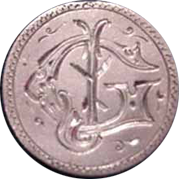
Here are the letters "JG" or "GJ" depending on how you want to read them. It was engraved on the reverse of an 1857 dime. Two initials are a little harder to find. This one also has a border engraved around the edge. The more elaborate engraving and the border would make this love token more desirable than the plainer one (JSG) above.
Also under challenge or interpretation is the coin of the realm notion. Medals and tokens that have been engraved and presented to the masses are clearly not love tokens. But what of a war medal that is hand engraved, one of a kind, and on a personal note? Let’s say a son dies in war and the family is given a medal. Then the father has it enameled in black with the son’s name and presents it to his wife, the boy’s mother. Is this any less of a love token if all the sentiments are there? Again, it is up to the collector whether they wish to accept it in their own collection. Opinions will vary.
Although it is traditionally believed that these coins were given by a beau to a girl, they extended far beyond those traditional boundaries. They were also given by every imaginable family member as well as friends. A craze had sweep the country and school girls were begging and pleading for love tokens. Probably because the love token bracelet was the most popular form of love token jewelry and it took about eight to make a bracelet.
Engravings were executed on practically all denominations of coins, but the Liberty Seated dime was the most popular denomination. There is some speculation as to the reasons. These silver coins were softer, thus easier to engrave than nickel and were a more precious gift than a nickel or the lowly copper cent. The United States also produced a half dime made from silver and some engraved on these, but it was a rather small size and perhaps challenging for the engraver to fit a pleasing design so small. The quarter too was popular but two and a half times as costly made it an alternative to those with a bigger purse. Remember, money was worth a lot more in those days.
Gold coins were used occasionally. A one dollar gold coin was ten times the cost of a dime and was at best half the size of a dime. Although gold, it really did not look like much because of its small size. This is especially true of the type I gold dollars as the type II was a broader coin than its predecessor. A 2 ½ gold coin was equivalent in size to the dime but quite costly to use as a trinket. Truly rare and exceedingly scarce is the twenty dollar gold coin love token. This would have only been commissioned by a very wealthy man but from a practicality standpoint; it would have been rather heavy to wear.
Interestingly enough, a significant number of the copper and nickel coins that were engraved were also gold plated. A poor person might have used this denomination and then by gold plating them, made them look like their gold counterpoint coins. The Indian cent and the liberty nickel bear some visual similarities to a 2 ½ Indian and a 2 ½ Liberty gold coin.
Whatever the host coin, the feelings and emotions were the same. Some could just afford to show their love more than others. People were quite sentimental in the Victorian age and love tokens are an enduring testament to those feelings.
